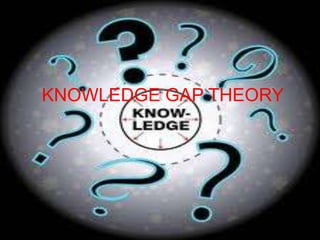Knowledge gap theory
•Descargar como PPTX, PDF•
19 recomendaciones•20,303 vistas
Denunciar
Compartir
Denunciar
Compartir

Recomendados
Más contenido relacionado
La actualidad más candente
La actualidad más candente (20)
Destacado
Destacado (17)
Introduction to Communication, Media, Culture, and Society

Introduction to Communication, Media, Culture, and Society
Mass Media and Society, Chapter 1: Media and Culture

Mass Media and Society, Chapter 1: Media and Culture
Role and impact of media on society final ppt............

Role and impact of media on society final ppt............
Similar a Knowledge gap theory
Similar a Knowledge gap theory (20)
Knowledge gap- Information Rich and Information Poor

Knowledge gap- Information Rich and Information Poor
How will you close your knowledge gap- Is your mind geared to re-think.docx

How will you close your knowledge gap- Is your mind geared to re-think.docx
Public Understanding of Science - Lecture 2 #SciCommLSU

Public Understanding of Science - Lecture 2 #SciCommLSU
6.4 - Relationship between Producers and Audience.pptx

6.4 - Relationship between Producers and Audience.pptx
Mil and intercultural dialogue course outline (basic) latest

Mil and intercultural dialogue course outline (basic) latest
Knowledge Gap: The Magic behind Knowledge Expansion

Knowledge Gap: The Magic behind Knowledge Expansion
chapter-5-media-and-digital-or-cyber-literacies.pdf

chapter-5-media-and-digital-or-cyber-literacies.pdf
chapter-5-media-and-digital-or-cyber-literacies.pdf

chapter-5-media-and-digital-or-cyber-literacies.pdf
Open Data and Media Literacies: Educating for Democracy 

Open Data and Media Literacies: Educating for Democracy
Más de Punjab University Lahore
Más de Punjab University Lahore (20)
2 searching and finding information sources-khalid

2 searching and finding information sources-khalid
Knowledge gap theory
- 2. The Knowledge Gap Hypothesis was first proposed in 1970 by Tichenor, Donohue and OLien. Mostly, it is known as Tichenorl or Tichenor and his colleagues’ hypothesis. This theory is concerned mainly with “information” and “knowledge” and emphasizes that knowledge is not distributed equally throughout society.
- 3. Content Mass Media’s Role Knowledge Gap Theory
- 4. Mass Media’s Role:- One of the great promises of mass communication is that it provides people with information they need. It has the potential of reaching people who have not been reached by other means (poor and undeveloped people). Example:- Sesame Street (which combined information with entertainment for preschool Children.).
- 5. Knowledge gap Hypothesis:- “As the infusion of mass media information into a social system increases, segments of the population with higher socio-economic status tend to acquire this information at a faster rate than the lower status segments, so that the gap in knowledge between these two segments tend to increase rather than decrease”.
- 6. The hypothesis predicts that: People of both high and low socioeconomic statuses will gain in knowledge because of the additional information, but that persons of higher socioeconomic status will gain more. This would mean that the relative gap in knowledge between the well-to-do and less well-off would increase.
- 7. Operational forms of the Hypothesis: As seen in the following hierarchy, where the knowledge gap exists is between "Information" and "Knowledge". 1) OVER TIME, acquisition of knowledge of a heavily publicized topics will proceed at a faster rate among better educated person than among those with less education 2) AT A GIVEN POINT there should be a higher correlation between acquisition of knowledge and education for topics highly publicized in the media than for topics less highly publicized
- 8. Possible reasons for Knowledge Gap: Communication skills Stored information Relevant social contact Selective exposure Media target markets
- 9. Knowledge gaps are not intractable. Contributory conditions that could reduce knowledge gaps: - content domains, channel influence, social conflict and community mobilization, the structure of communities, individual motivational factors.
- 10. Criticism Dervin (1980) criticized the KG for being based on the traditional source-sending-messages –to-receiver paradigm of communication. She recommended that communication campaigns and researchers be more user-based and user-constructed information. Evatt (1998) argued that researchers should be sure that the information they are testing is useful and relevant for the audience being tested. (Factual versus conceptual knowledge)
